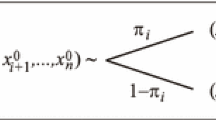Abstract
Several advances in multiattribute expected utility theory have emerged recently. Much of the existing theory deals with independence axioms on whole attributes and the corresponding utility decompositions. This paper reviews three alternate approaches for obtaining representations of multiattribute utility functions: (1) multi-valent preference analysis, (2) approximation methods, and (3) indifference spanning analysis. Unlike some utility decompositions, these approaches require the assessment of only single-attribute functions which makes implementation relatively simple. Only multivalent preference analysis and indifference spanning analysis, however, provide axioms that can be empirically tested to justify a particular utility representation.
Similar content being viewed by others
References
Bell, David E., ‘Interpolation Independence’, in S. Zionts (ed.), Multiple Criteria Problem Solving, Lecture Notes in Economics and Mathematical Systems, 155, Springer-Verlag, Berlin, 1–7, 1978.
Bell, David E., ‘Consistent Assessment Procedures Using Conditional Utility Functions’, Operations Research 27 (1979a), 1054–1066.
Bell, David E., ‘Multiattribute Utility Functions: Decompositions Using Interpolation’, Management Science 25 (1979b), 744–753.
Farquhar, Peter H., ‘Fractional Hypercube Decompositions of Multiattribute Utility Functions’, Technical Report 222, Department of Operations Research, Cornell University, Ithaca, New York, 1974.
Farquhar, Peter H., ‘A Fractional Hypercube Decomposition Theorem for Multi-attribute Utility Functions’, Operations Research 23 (1975), 941–967.
Farquhar, Peter H., ‘Pyramid and Semicube Decompositions of Multiattribute Utility Functions’, Operations Research 24 (1976), 256–271.
Farquhar, Peter H., ‘A Survey of Multiattribute Utility Theory and Applications’, in M. K. Starr and M. Zeleny (eds.), Multiple Criteria Decision Making, North-Holland/TIMS Studies in the Management Sciences 6 (1977), 59–89.
Farquhar, Peter H., ‘Interdependent Criteria in Utility Analysis’, in S. Zionts (ed.), Multiple Criteria Problem Solving, Lecture Notes in Economics and Mathematical Systems, 155, Springer-Verlag, Berlin, 131–180, 1978.
Farquhar, Peter H., ‘Multivalent Preference Structures’, Mathematical Social Sciences 1 (1980).
Farquhar, Peter H. and Fishburn, Peter C., ‘Equivalence and Continuity in Multivalent Preference Structures’, Operations Research 29 (1981).
Farquhar, Peter H. and Rao, Vithala R., ‘A Balance Model for Evaluating Subsets of Multiattributed Items’, Management Science 22 (1976), 528–539.
Fishburn, Peter C., ‘Independence in Utility Theory with Whole Product Sets’, Operations Research 13 (1965), 28–45.
Fishburn, Peter C., Utility Theory for Decison Making, Wiley, New York, 1970.
Fishburn, Peter C., ‘Bernoullian Utilities for Multiple-Factor Situations’, in J. L. Cochrane and M. Zeleny (eds.), Multiple Criteria Decision Making, University of South Carolina Press, Columbia, South Carolina, 47–61, 1973.
Fishburn, Peter C., ‘von Neumann-Morgenstern Utility Functions on Two Attributes’, Operations Research 22 (1974), 35–45.
Fishburn, Peter C., ‘Approximations of Two-Attribute Utility Functions’, Mathematics of Operations Research 2 (1977), 30–44.
Fishburn, Peter C., ‘Approximations of Multiattribute Utility Functions’, Journal of Approximation Theory 27 (1979), 179–196.
Fishburn, Peter C. and Farquhar, Peter H., ‘Finite-Degree Utility Independence’, unpublished manuscript, Bell Telephone Laboratories, Murray Hill, New Jersey, 1979.
Fishburn, Peter C. and Keeney, Ralph L., ‘Seven Independence Conditions and Continuous Multiattribute Utility Functions’, Journal of Mathematical Psychology 11 (1974), 294–327.
Fishburn, Peter C. and Keeney, Ralph L., ‘Generalized Utility Independence and Some Implications’, Operations Research 23 (1975), 928–940.
Johnson, Edgar M. and Huber, George P., ‘The Technology of Utility Assessment’, IEEE Transactions on Systems, Man, and Cybernetics SMC-7 (1977), 311–325.
Keeney, Ralph L., ‘Quasi-Separable Utility Functions’, Naval Research Logistics Quarterly 15 (1968), 551–565.
Keeney, Ralph L., ‘Utility Independence and Preferences for Multiattributed Consequences’, Operations Research 19 (1971), 875–893.
Keeney, Ralph L., ‘Utility Functions for Multiattributed Consequences’, Management Science 18 (1972), 276–287.
Keeney, Ralph L., ‘Multiplicative Utility Functions’, Operations Research 22 (1974), 22–34.
Keeney, Ralph L. and Raiffa, Howard, Decision with Multiple Objectives: Preferences and Value Tradeoffs, Wiley, New York, 1976.
Kirkwood, Craig W., ‘Parametrically Dependent Preferences for Multiattributed Consequences’, Operations Research 24 (1976), 92–103.
Meyer, Richard F., ‘State-Dependent Time Preference’, in D. E. Bell, R. L. Keeney and H. Raiffa (eds.), Conflicting Objectives in Decisions, Wiley, New York, 232–243, 1977.
Nahas, Khaled H., ‘Preference Modeling of Utility Surfaces’, unpublished doctoral dissertation, Department of Engineering-Economic Systems, Stanford University, Stanford, California, 1977.
Pollak, Robert A., ‘Additive von Neumann-Morgenstern Utility Functions’, Econometrica 35 (1967), 485–494.
Raiffa, Howard, ‘Preferences for Multiattributed Alternatives’, RM-5868-DOT/RC, The RAND Corporation, Santa Monica, California, 1969.
Tamura, Hiroyuki and Nakamura, Yutaka, ‘Decompositions of Multiattribute Utility Functions Based on a New Concept of Convex Dependence’, Proceedings of International Conference on Cybernetics and Society, IEEE Systems, Man, and Cybernetics Society, Tokyo, 1978a.
Tamura, Hiroyuki and Nakamura, Yutaka, ‘Convex Decomposition of a Two-Attribute Utility Function for Pollution and Consumption’, unpublished manuscript, Department of Precision Engineering, Osaka University, Osaka, Japan, 1978b.
von Neumann, John and Morgenstern, Oskar, Theory of Games and Economic Behavior, 2nd Edition, Wiley, New York, 1947.
Author information
Authors and Affiliations
Additional information
This research was supported in part by the Office of Naval Research under Contract No. N00014-78-C-0638, Task No. NR-277-258.
Rights and permissions
About this article
Cite this article
Farquhar, P.H. Advances in multiattribute utility theory. Theor Decis 12, 381–394 (1980). https://doi.org/10.1007/BF00131317
Issue Date:
DOI: https://doi.org/10.1007/BF00131317




